See also
| |||||||||||||||||||||||||||||
| |||||||||||||||||||||||||||||
This list of practice weapons, is of weapons specifically designed for practice in different martial arts from around the world. Unlike those in the list of martial arts weapons article, many of which are designed to be effective weapons, generally those listed here are blunted or otherwise designed for safe regular practice and training.
A bokken is a Japanese wooden sword used for training in kenjutsu. It is usually the size and shape of a katana, but is sometimes shaped like other swords, such as the wakizashi and tantō. Some ornamental bokken are decorated with mother-of-pearl work and elaborate carvings. Sometimes, it is spelled "boken" in English.
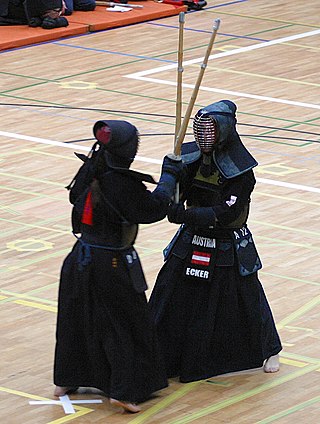
Kendo is a modern Japanese martial art, descended from kenjutsu, that uses bamboo swords (shinai) as well as protective armor (bōgu). Today, it is widely practiced within Japan and has spread to many other nations across the world.

Kenjutsu (剣術) is an umbrella term for all (ko-budō) schools of Japanese swordsmanship, in particular those that predate the Meiji Restoration. Some modern styles of kendo and iaido that were established in the 20th century also included modern forms of kenjutsu in their curriculum. Kenjutsu, which originated with the samurai class of feudal Japan, means "methods, techniques, and the art of the Japanese sword". This is opposed to kendo, which means "the way of the sword" and uses a bamboo sword (shinai) and protective armour (bōgu).
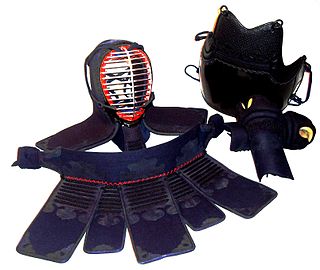
Bōgu, properly called kendōgu, is training armour used primarily in the Japanese martial art of kendo, with variants used for jūkendō, tankendo, and naginata.

Japanese martial arts refers to the variety of martial arts native to the country of Japan. At least three Japanese terms are used interchangeably with the English phrase Japanese martial arts.

A club is a short staff or stick, usually made of wood, wielded as a weapon since prehistory. There are several examples of blunt-force trauma caused by clubs in the past, including at the site of Nataruk in Turkana, Kenya, described as the scene of a prehistoric conflict between bands of hunter-gatherers 10,000 years ago.

Swordsmanship or sword fighting refers to the skills and techniques used in combat and training with any type of sword. The term is modern, and as such was mainly used to refer to smallsword fencing, but by extension it can also be applied to any martial art involving the use of a sword. The formation of the English word "swordsman" is parallel to the Latin word gladiator, a term for the professional fighters who fought against each other and a variety of other foes for the entertainment of spectators in the Roman Empire. The word gladiator itself comes from the Latin word gladius, which is a type of sword.

Singlestick is a martial art that uses a wooden stick as its weapon. It began as a way of training soldiers in the use of backswords. Canne de combat, a French form of stick fighting, is similar to singlestick play, which also includes a self-defense variant with a walking stick.

The iaitō (居合刀) is a modern metal practice sword, without a cutting edge, used primarily for practicing iaido, a form of Japanese swordsmanship.
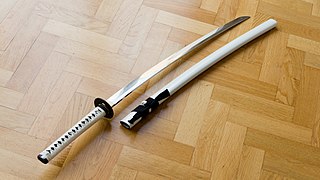
Shinken is a Japanese sword that has a forged and sharpened blade. The term shinken is often used in contrast with bokken, shinai, and iaitō.
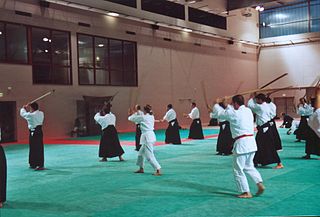
Aiki-ken is the name given specifically to the set of Japanese sword techniques practiced according to the principles of aikido, taught first by Morihei Ueshiba, then further developed by Morihiro Saito, one of Ueshiba's most prominent students. Currently, Iwama Shin-Shin Aiki Shuren-kai is the main proponent organization.

Stick-fighting, stickfighting, or stick fighting, is a variety of martial arts which use simple long, slender, blunt, hand-held, generally wooden "sticks" for fighting, such as a gun staff, bō, jō, walking stick, baston, arnis sticks or similar weapons. Some techniques can also be used with a sturdy umbrella or even with a sword or dagger in its scabbard.
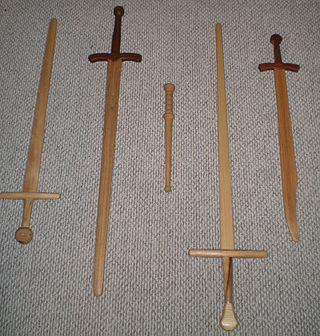
In martial arts, a waster is a practice weapon, usually a sword, and usually made out of wood, though nylon (plastic) wasters are also available. Nylon is safer than wood, due to it having an adequate amount of flex for thrusts to be generally safe, unlike wooden wasters. Even a steel feder has more flex than most wooden wasters. The use of wood or nylon instead of metal provides an economic option for initial weapons training and sparring, at some loss of genuine experience. A weighted waster may be used for a sort of strength training, theoretically making the movements of using an actual sword comparatively easier and quicker, though modern sports science shows that an athlete would most optimally train with an implement which is closest to the same weight, balance, and shape of the tool they will be using. Wasters as wooden practice weapons have been found in a variety of cultures over a number of centuries, including ancient China, Ireland, Iran, Scotland, Rome, Egypt, medieval and renaissance Europe, Japan, and into the modern era in Europe and the United States. Over the course of time, wasters took a variety of forms not necessarily influenced by chronological succession, ranging from simple sticks to clip-point dowels with leather basket hilts to careful replicas of real swords.
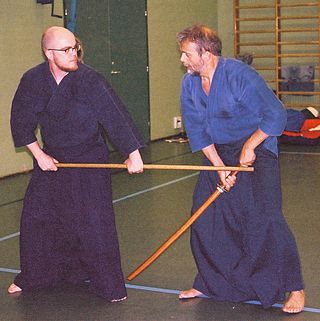
Shintō Musō-ryū, or Shindō Musō-ryū (神道夢想流), most commonly known by its practice of jōdō, is a traditional school (koryū) of the Japanese martial art of jōjutsu, or the art of wielding the short staff (jō). The technical purpose of the art is to learn how to defeat a swordsman in combat using the jō, with an emphasis on proper combative distance, timing and concentration. The system includes teachings of other weapon systems which are contained in Shintō Musō-ryū as auxiliary arts. The school is sometimes abbreviated as SMR.
A suburitō (素振り刀) is a type of bokken, a wooden practice sword originating in Japan and used in Japanese martial arts. Suburi means "practice swing"; a suburitō is therefore used to practice sword-swinging.
Dave Lowry is an American writer best known for his articles, manuals and novels based on Japanese martial arts.

Zen Nihon Kendō Renmei Jōdō, or Seitei Jōdō in short, is a modern form of jōdō created by Japanese martial artist Shimizu Takaji and presented to the All Japan Kendo Federation in 1968.

A shinai (竹刀) is a Japanese sword typically made of bamboo used for practice and competition in kendo. Shinai are also used in other martial arts, but may be styled differently from kendo shinai, and represented with different characters. The light, soft wood used in a shinai distinguishes it from other wooden swords such as a bokken, which is generally made of heavier, sturdier wood.
Training weapon may refer to: